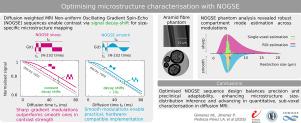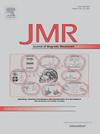梯度波形调制对非均匀振荡梯度自旋回波序列微结构表征的优化及影响
IF 1.9
3区 化学
Q3 BIOCHEMICAL RESEARCH METHODS
引用次数: 0
摘要
神经系统疾病通常导致神经系统在微观尺度上的变化,强调了对非侵入性成像技术的需求,这种技术可以量化这些变化,作为诊断的潜在生物标志物。扩散加权磁共振成像(DWI),特别是使用调制梯度自旋回波(MGSE)序列,在通过探测分子扩散来揭示组织微观结构方面取得了显著进展。在MGSE序列中,非均匀振荡梯度自旋回波(NOGSE)序列通过信号衰减移位产生基于选择性微观结构尺寸的对比度,而不是探测传统的衰减率。在这项研究中,我们使用临床前MRI扫描仪评估了NOGSE在估计微观结构尺寸方面的性能。我们的研究结果表明,虽然尖锐的瞬时梯度调制使衰减位移最大化,但平滑的梯度调制仍然提供有意义的对比度。通过模拟实验、数值模拟和信息论分析相结合,我们优化了NOGSE参数,以准确估计尖锐和光滑梯度调制下的微结构尺寸。我们确定了与临床前硬件限制兼容的最佳NOGSE参数,提供了可靠的微观结构尺寸表征。特别是平滑的梯度调制扩展了兼容MRI扫描仪的范围,几乎适用于体内应用。这些发现代表了开发定量成像工具的一步,用于探测扩散加权磁共振成像中的微观结构特征。本文章由计算机程序翻译,如有差异,请以英文原文为准。

Optimisation and impact of gradient waveform modulation on Non-uniform Oscillating Gradient Spin-Echo sequences for microstructural characterisation
Neurological diseases often result in changes at microscopic scales in the nervous system, emphasising the need for non-invasive imaging techniques that can quantify these alterations as potential biomarkers for diagnosis. Diffusion-weighted magnetic resonance imaging (DWI), particularly using modulated gradient spin-echo (MGSE) sequences, has significantly advanced in revealing tissue microstructure by probing molecular diffusion. Among the MGSE sequences, the Non-uniform Oscillating Gradient Spin-Echo (NOGSE) sequence generates a contrast based on selective microstructure sizes through a signal decay-shift, rather than probing conventional decay rates. In this study, we evaluate the performance of NOGSE in estimating microstructure sizes using a preclinical MRI scanner. Our results show that while sharp, instantaneous gradient modulations maximise the decay-shift, smooth gradient modulations still provide meaningful contrast. Through a combination of phantom experiments, numerical simulations and information-theoretic analysis, we optimise NOGSE parameters for accurate microstructural size estimation under both sharp and smooth gradient modulations. We identify optimal NOGSE parameters that are compatible with preclinical hardware constraints, providing reliable microstructure size characterisation. Especially smooth gradient modulations expand the range of compatible MRI scanners and are almost suitable for in-vivo applications. These findings represent a step toward developing quantitative imaging tools for probing microstructural features in diffusion-weighted magnetic resonance imaging.
求助全文
通过发布文献求助,成功后即可免费获取论文全文。
去求助
来源期刊
CiteScore
3.80
自引率
13.60%
发文量
150
审稿时长
69 days
期刊介绍:
The Journal of Magnetic Resonance presents original technical and scientific papers in all aspects of magnetic resonance, including nuclear magnetic resonance spectroscopy (NMR) of solids and liquids, electron spin/paramagnetic resonance (EPR), in vivo magnetic resonance imaging (MRI) and spectroscopy (MRS), nuclear quadrupole resonance (NQR) and magnetic resonance phenomena at nearly zero fields or in combination with optics. The Journal''s main aims include deepening the physical principles underlying all these spectroscopies, publishing significant theoretical and experimental results leading to spectral and spatial progress in these areas, and opening new MR-based applications in chemistry, biology and medicine. The Journal also seeks descriptions of novel apparatuses, new experimental protocols, and new procedures of data analysis and interpretation - including computational and quantum-mechanical methods - capable of advancing MR spectroscopy and imaging.

 求助内容:
求助内容: 应助结果提醒方式:
应助结果提醒方式:


